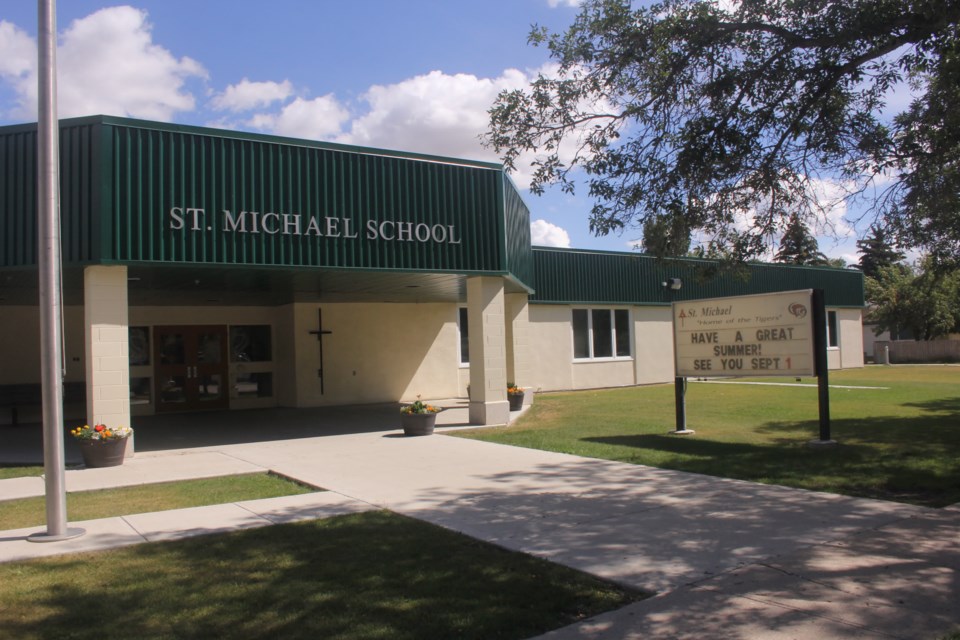By Greg Nikkel
Students of the Holy Family Roman Catholic Separate School Division achieved above the provincial average, and above set targets for achievement, the board of trustees heard at their monthly board meeting on Wednesday evening.
The student achievement report covered how well the Grades 1-9 students did in the core areas of math and reading, the readiness of kindergarten students for entering the school system, and the level of engagement that students in Grades 4-9 have with their schools.
The goals for both math and reading by the year 2020 is for 80 per cent of students in Grades 1-9 to achieve their grade level or above according to provincial curricular standards. For kindergarten readiness, the goal is for 90 per cent of kindergarten students to be ready to learn, according to the Early Years assessment.
The goal for student engagement is for Grades 4-9 to self-report a level of engagement that is above Canadian norms as measured by the Our School survey.
In reading, Holy Family students in Grades 1-9 overall had 78 per cent of students reading at or above their grade level, compared to the provincial average of 71 per cent for Grades 1-3. Holy Family students in Grades 1 and 2 are above the provincial average for reading, with Grade 2 at 14 per cent above the average.
For math, they didn’t have provincial numbers for achievement (as they are piloting a new curriculum), but trustees were told that Grades 1-9 exceeded the 80-per-cent target with 84 per cent at or above their grade level of achievement. This was down slightly from last year when 87 per cent of students achieved this goal, and this year the Grade 7 students seemed to struggle with the math curriculum.
On the topic of engagement, there was an improved response by students well above the Canadian norm for schools. In Holy Family, 81 per cent of students in Grades 7 to 9 have aspirations for finishing high school, above the Canadian norm.
Also, students in Grades 4-6 told the school division that involvement in sports and clubs was important, and 97 per cent “believe education will benefit them personally.”
The Grades 4-9 students were also asked the question, “To do my best learning and be prepared for my future, I need …”
The top responses to this question from Grades 4-6 included the wish “to clearly understand why and what I am learning and how it will help me in the real world”; “less noise in my classrooms”; “different kinds of tables, desks, chairs and seating in my classrooms”; “to work together with others, digitally and in person, on school assignments”; and “to feel safe and encouraged to try new ways of showing what I know”.
The responses from students in Grades 7-9 included “to use technology tools and have a choice in programs to do my school work”; “to clearly understand why and what I am learning”; “to get feedback quickly to improve my work”; “to have less noise in my classroom”; and “to collaborate with others, digitally or in person, on school assignments”.
The schools will focus on the students voice and student choices, said education director Gwen Keith, “for children who don’t learn best in traditional ways, that is appreciated. By focusing on a more personalized approach, we’re going to see a shift in all students.”
Schools lapsed in reading and writing for many years, pointed out board chair Bruno Tuchscherer, which resulted in adults who have trouble in those areas. From his grandchildren, however, “I think their writing is better than I’ve seen for years.”
Keith noted that they are starting much earlier, in kindergarten and pre-kindergarten, and are starting on the basis for learning at their level so “it’s a lot more fun for them.”
A trustee asked if maybe the target goal levels are set too high, and Keith replied, “The standards are created by groups of directors. There’s no research behind the push targets, they were just developed to be age appropriate at the time.”
She said the schools will compile data to see how students learn and grow, and to see what areas teachers need to make improvements on for that learning.
The emphasis also in Holy Family is to ensure there is solid 21st century learning, and with the tools they are using, “what we’re doing is leveraging the technologies to go deeper than we’ve ever done before, and make it much more efficient for principals,” said Keith.
There will also be a focus on student voice, on using inquiry and personalized learning, on fusing more technology into schools (such as the Deeper Learning Lab at St. Michael School), develop partnerships with critical friends and other school divisions, and have more SCC involvement and school-wide engagement events.



